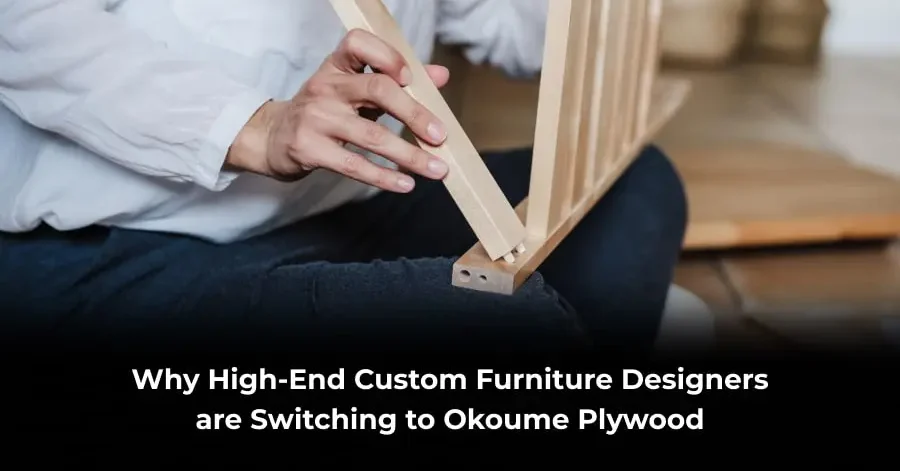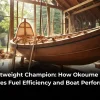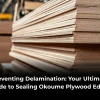Walk into the studio of a discerning custom furniture maker today, and you might notice a shift. Amidst the slabs of walnut, oak, and maple, you’ll find stacks of a distinctive, honey-toned sheet material. This isn’t your average construction-grade plywood; this is Okoume plywood, and it’s quietly revolutionizing the world of high-end, bespoke furniture.
For decades, the narrative of luxury furniture was dominated by solid wood. But a new chapter is being written, one where innovation meets artistry. The most forward-thinking designers and craftspeople are embracing this unique material, not as a compromise, but as a superior choice for creating heirloom-quality pieces. The question is, why? What is it about this particular Okoume plywood that is causing such a stir in ateliers and workshops?
The Heart of the Matter: What Exactly is Okoume?
Before we dive into the “why,” let’s understand the “what.” Okoume (pronounced oh-KOO-mee) is a tree native to Gabon in West Africa. It’s known for its rapid growth and, most importantly for woodworkers, its exceptionally fine, uniform grain and soft, lightweight properties. When this wood is sliced into thin veneers and laminated with waterproof adhesives, it becomes what we know as Okoume marine plywood.
The term “marine” is key. While not all furniture will live on a yacht, the designation signifies a core strength: resilience. The adhesives used are designed to withstand prolonged exposure to moisture without delaminating. This inherent stability is the foundation of its appeal to furniture makers who demand longevity from their creations.
Beyond the Solid Wood Dogma: The Unmatched Benefits for Furniture Design
The switch to Okoume plywood isn’t about cutting corners; it’s about unlocking creative potential. Here are the core reasons designers are making the move:
- A Dream to Work With: Unparalleled Machinability
High-end furniture often involves complex curves, intricate inlays, and precise joinery. Okoume is famously forgiving and easy to work with. Its uniform density means it cuts cleanly without splintering, sands to a silky-smooth finish, and holds delicate edges beautifully. For a designer spending hours on a detailed piece, this lack of fight translates to a more enjoyable process and a flawless final product. Unlike some dense hardwoods that can blunt tools quickly, Okoume plywood is a carpenter’s ally. - The Featherweight Champion
Imagine a large, statement dining table or a modular shelving unit that is surprisingly easy to move. That’s the magic of Okoume. It’s one of the lightest commercially available plywoods, a huge advantage for both the maker and the client. Designers can create bold, substantial forms without the back-breaking weight of solid wood or heavier sheet goods. This makes shipping more affordable and installation less of a logistical nightmare, benefits that can be passed on to the customer. - The Canvas is Everything: A Perfect Painting and Finishing Surface
The face veneer of high-grade Okoume plywood is a thing of beauty. It’s consistently smooth, with a minimal, tight grain that lacks the large, porous voids found in other plywoods like lauan. This makes it an impeccable substrate for high-gloss lacquers, vibrant paints, and transparent stains. The color doesn’t blotch, and the finish remains mirror-smooth. For designers who specialize in colored furniture or who want the wood’s natural, warm, pinkish-blonde hue to shine through with a clear coat, it’s the perfect canvas. - Stability That Defies the Elements (and Your Home’s HVAC)
Solid wood is alive; it expands and contracts with changes in humidity and temperature. This movement can lead to cracks, warping, and stuck drawers over time. The cross-laminated structure of plywood inherently resists this movement. When you use a high-quality Okoume marine plywood, that stability is supercharged. It’s engineered to handle moisture swings, meaning a cabinet door will still fit perfectly years later, and a tabletop will remain flat and true, regardless of the season. This reliability is a cornerstone of true heirloom quality. - Sustainability and Conscious Sourcing
Today’s luxury client is increasingly eco-conscious. Okoume is often harvested from sustainably managed forests, and because the plywood uses thin veneers, it is a highly efficient use of the timber. One log can produce a vast amount of veneer compared to being milled into solid lumber. For designers and their clients who value environmental responsibility, choosing a sustainably sourced Okoume plywood is a meaningful part of the story behind the piece.
Decoding the Language of Quality: The Wood Grading System
Not all Okoume plywood is created equal. This is where understanding the wood grading system is non-negotiable for a serious designer. The wood grading system for plywood typically involves two letters (e.g., A-A, A-B, B-B) that refer to the quality of the face and back veneers.
- A Grade: Nearly perfect. Smooth, solid surface with minimal repairs. This is the go-to for furniture that will be visible or have a clear finish.
- B Grade: Solid surface but may contain more patches and repairs. Suitable for pieces that will be painted or where the back won’t be seen.
- C / D Grade: Contain more knots and open defects. Used for structural sheathing, not fine furniture.
A high-quality Okoume marine plywood for furniture will often be A-A or A-B. Paying attention to this wood grading system ensures you’re getting a material worthy of your design vision. A reputable supplier will be transparent about their grading, a crucial part of the trust equation in the wood grading system.
Where Craft Meets Quality: The AEW Woods Connection
For a designer, the source of their materials is as important as the tools they use. Finding a supplier that provides consistently high-quality, reliably stocked material is a game-changer. This is where a specialist like AEW Woods enters the narrative.
AEW Woods has built a reputation as a premier supplier of exotic and specialty woods, and their commitment to quality is evident in their selection of Okoume plywood. They understand that a furniture maker isn’t just buying a sheet of wood; they are investing in the foundation of their art. By sourcing from a supplier like AEW Woods, designers can be confident they are getting a product that adheres to a strict wood grading system, ensuring every sheet of Okoume marine plywood meets the high standards required for custom furniture. The expertise and customer-centric approach of companies like AEW Woods make them a valued partner in the creative process, providing not just materials, but peace of mind.
Also Read- What is a Wood Grading System? The Ultimate Guide for Professionals
Conclusion
The movement of high-end custom furniture designers towards Okoume plywood is a testament to a smarter, more nuanced approach to craftsmanship. It’s a decision driven not by cost, but by capability. It represents a fusion of the natural beauty we cherish in wood with the intelligent engineering required for modern, lasting design.
By choosing this remarkable material, designers are freeing themselves from the limitations of solid wood, embracing lighter weight, superior stability, and a flawless finishing surface. They are partnering with knowledgeable suppliers who understand the critical importance of a reliable wood grading system, ensuring that every project begins on a foundation of quality. In the end, the switch to Okoume plywood isn’t just about using a different material; it’s about building a better, more beautiful, and more enduring future for custom furniture, one exquisite piece at a time.
Frequently Asked Questions (FAQs)
- Is Okoume plywood strong enough for furniture like chairs and tables?
Absolutely. While it is lightweight, the cross-laminated plywood construction gives it exceptional strength-to-weight ratio. For load-bearing furniture like chairs and tables, proper design and engineering (such as using adequate thickness and supportive structures) are key. When used correctly, it is more than strong enough for demanding applications. - Can I use regular Okoume plywood in a bathroom or kitchen?
For areas with persistent high humidity, it is highly recommended to use Okoume marine plywood. The “marine” designation means it uses waterproof adhesives that prevent the layers from separating when exposed to moisture, making it ideal for cabinetry and furniture in bathrooms, kitchens, and even damp climates. - How does the cost of Okoume compare to other materials?
High-quality Okoume plywood is generally more expensive than standard domestic plywood (like birch) but can be more affordable than premium solid hardwoods or ultra-high-end plywoods like Baltic birch. Its value lies in its unique combination of light weight, stability, and superb finishability, offering a fantastic return on investment for the quality achieved. - What does the “A-A” grading mean on a sheet of Okoume plywood?
This refers to the wood grading system. The first “A” denotes a premium, virtually defect-free face veneer. The second “A” means the back veneer is also of the same high quality. An “A-B” sheet would have a premium face and a good-but-slightly-less-perfect back, which is often a cost-effective choice for furniture where the back won’t be visible. - Why would a designer choose Okoume over a very stable MDF for painting?
While MDF is very stable and smooth, it is extremely heavy and lacks the structural integrity of plywood. It also does not hold screws as well and is susceptible to water damage. Okoume plywood offers a much stronger, lighter, and more moisture-resistant core with a superior veneer surface that, when sealed, provides an impeccable and durable painted finish.






